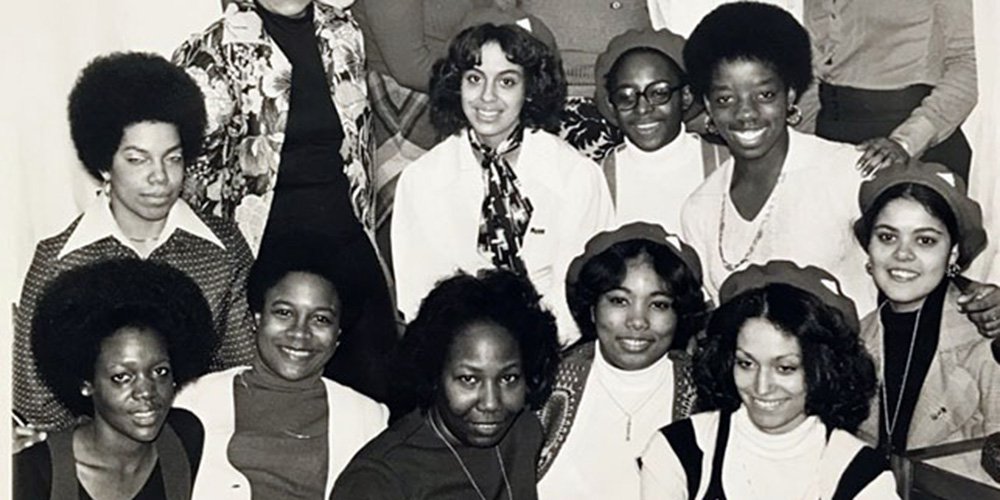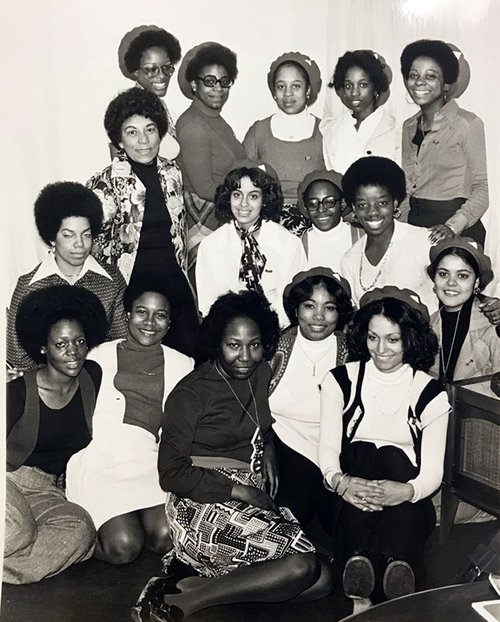Processing the Papers of Constance Timberlake

by Emily Banach, Graduate Student Assistant
At the start of this post, I want to acknowledge the fact that I am a white woman in a white-dominated field, and that this undoubtedly influences how I understand and perform archival work.
I started working as a graduate assistant for the Special Collection Research Center’s University Archives in February 2021 to learn more about practical archival work and to supplement my coursework as an MSLIS student at Syracuse University’s iSchool. While I’ve certainly been learning a lot about processing collections, rehousing materials, and other archival practices, I’ve also been learning about some of the larger undertakings in archival work. One of the concepts that has stood out the most to me has been the idea of reparative archives. In its essence, reparative archival work is the intentional inclusion and promotion of historical materials from individuals of color or from other marginalized and oppressed communities paired with public acknowledgement of the harm that archives have done by ignoring and suppressing these voices. Lae’l Hughes-Watkins describes the concept more fully in her article “Moving Toward a Reparative Archive: A Roadmap for a Holistic Approach to Disrupting Homogenous Histories in Academic Repositories and Creating Inclusive Spaces for Marginalized Voices” (2018):
Reparative archival work does not pretend to ignore the imperialist, racist, homophobic, sexist, ableist, and other discriminatory traditions of mainstream archives, but instead acknowledges these failures and engages in conscious actions toward a wholeness that may seem to be an exercise in futility but in actuality is an ethical imperative for all within traditional archival spaces.
Lae’l Hughes-Watkins, “Moving Toward a Reparative Archive: A Roadmap for a Holistic Approach to Disrupting Homogenous Histories in Academic Repositories and Creating Inclusive Spaces for Marginalized Voices” (2018), p. 4.
The University Archives has been engaging in reparative archival work by processing the papers of faculty of color, acknowledging racist or other discriminatory content in its collections, and searching for ways to revise outdated description in its finding aids. This summer, I was given the opportunity to participate in reparative archival work through an internship processing the collections of two faculty of color: Constance Timberlake, professor of human development from 1971 to 1993, and Hiroshi Higuchi, professor of aerospace engineering from 1989 to 2010. As I’m still in the midst of processing the Higuchi Papers, this post will focus on my experience processing the Constance Timberlake Papers.

Portrait of Constance Timberlake, circa 1981. Constance Timberlake Papers.
Timberlake (1930-2019) was a Syracuse University professor, civil and women’s rights activist, and local politician. She donated her papers to the University Archives in 2002 and 2004, and her collection is one of the few our repository has from Black faculty members.
Processing anyone’s papers is an interesting experience, because you learn more and more about them with each sheet of paper you come across, but the Timberlake Papers were astounding because of the sheer volume of accomplishments, community commitments, and research Timberlake achieved or engaged in during her life. The main thought running through my head while I processed this collection was, “How did she have time for all of this?” At any given moment it seemed that Timberlake was writing two essays, participating in three community groups, teaching at least one course, and running a political campaign, at the very least. I think learning about her life and drive to make the community better was one of the most impactful parts of my internship. Since there is a biography of her life in the finding aid, I’ll only mention a few examples of interesting collection items in this post. I encourage those who are interested in Timberlake’s life and career to check out the finding aid for more information.
Timberlake was a strong supporter of the Black student community on campus, and her papers have correspondence from students she mentored, programs from events hosted by the Student Afro-American Society (SAS), and materials from a course she created called “The Reality of Being Black and Female.” Timberlake was also the faculty advisor for Delta Sigma Theta, a sorority for Black students that focused on activities that benefit the Black community. This photograph of Timberlake with Delta Sigma Theta sisters is just one piece of the record of Timberlake’s involvement with the Black community on campus.

Photograph of Constance Timberlake and Delta Sigma Theta sisters, 1975. Constance Timberlake Papers.
The collection also has examples of Timberlake’s political activism in the larger Syracuse community. Timberlake was an activist for civil and women’s rights causes and believed in making the community better through direct involvement. In 1973, Timberlake ran a successful campaign for a seat on the Syracuse Board of Education. She was the only candidate endorsed by the Democratic, Liberal, and Republican parties and was the first Black woman elected to the Board. Her papers include the postcards, flyers, audiotapes for radio advertisements, and other materials used in her campaign.

Letterhead from Timberlake’s 1973 Board of Education campaign. Constance Timberlake Papers.
As I finished compiling the finding aid, I was thinking about the fact that I might have never learned about Timberlake if I hadn’t been the one to process her papers. I might have never learned such in-depth information about Delta Sigma Theta or SAS and the events they hosted, such as a Black Professionals Week, a five-day event where students could attend talks given by Black men and women from various professions and fields, and a university-wide conference for Black student work. These thoughts and realizations helped me understand the true need for reparative archives and other diversity, equity, and inclusion initiatives. The intentional decision to process the Constance Timberlake Papers shines a light on her history and that of the groups and individuals with whom she worked. In this way, the finding aid makes previously hard-to-find information about Black faculty and students on campus more discoverable to researchers and the Syracuse University community.
I hope that the finding aid for the Constance Timberlake Papers will lead to two things: 1.) more people learning about Timberlake and all that she accomplished, and 2.) a call for more representation of Black, Indigenous, people of color (BIPOC) in our campus’ history. Greater public support and advocacy from our institutions for reparative archival work would help to ensure that we are fully and accurately representing and documenting the history of BIPOC community members on campus while also honoring their individual lives and experiences.
Constance Timberlake Papers, University Archives, Special Collections Research Center, Syracuse University Libraries.
Additional sources:
Hughes-Watkins, L. (2018). Moving toward a reparative archive: A roadmap for a holistic approach to disrupting homogenous histories in academic repositories and creating inclusive spaces for marginalized voices. Journal of Contemporary Archival Studies, 5 (Article 6). Retrieved August 3, 2021 from https://elischolar.library.yale.edu/cgi/viewcontent.cgi?article=1045&context=jcas.
